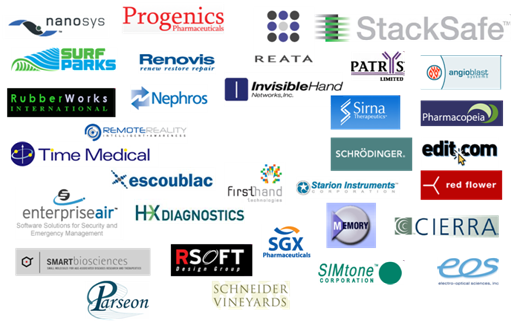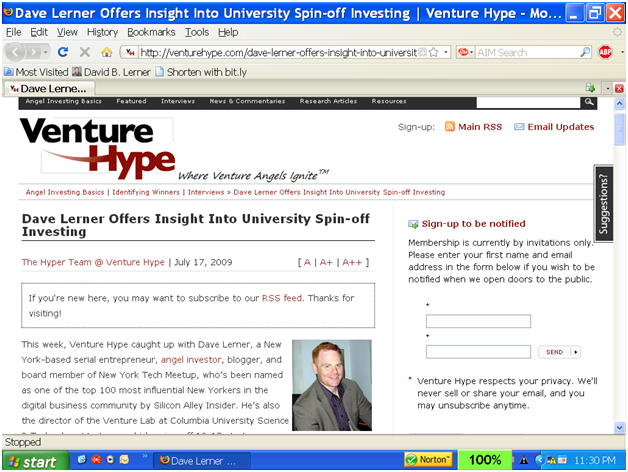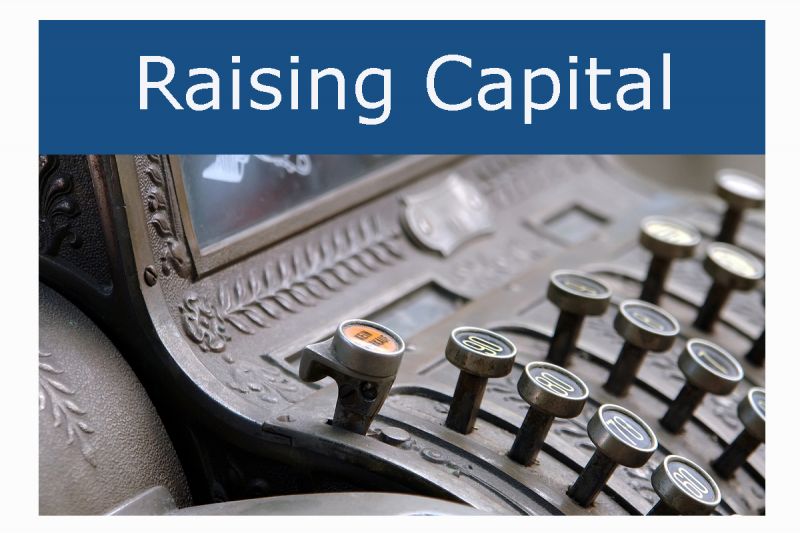This is part of my Series on University Entrepreneurship.
In the coming weeks I’ll be discussing the popular Entrepreneur Office Hours Program we launched at Columbia University’s Venture Lab some months ago. The program is open to anyone in the Columbia community and is scheduled on a rolling basis by appointment.
In the meantime, for all you fledgling entrepreneurs out there in universities around the country and overseas, I thought I’d begin to post some inspirational information on some of the successful exits Columbia’s portfolio companies have enjoyed over the years. Here are a few examples below.
Aton Pharma (Acquired by Merck for $150 million; NYSE: MRK)
http://www.merck.com/

The company is developing cancer drug targets based on research from R. Breslow of Chemistry and Sloan Kettering technology. Lead candidate is in Phase I/II clinical trials. The company was acquired by Merck for $150 million on February 2004.
CallStreet (Acquired by FactSet for $7 million)
http://www.callstreet.com/

CallStreet is the leading provider of corrected and formatted transcripts of management conference calls to the investment community. Hundreds of leading firms rely on CallStreet for the most accurate, highest quality content available. The company was acquired by FactSet in May 2004.
Corixa (Acquired by GSK for $300 million)
http://www.gsk.com/

Corixa is a biotechnology company involved in the identification of novel genes. The company develops immunotherapeutics that treat and prevent autoimmune diseases, cancer, and infectious diseases by understanding and directing the immune system. Corixa was acquired by GSK for $300 million on May 2005.
CoTherix/Exhale Therapeutics (Acquired by Actelion Pharmaceuticals; NASDAQ: CTRX)
http://www.cotherix.com

CoTherix is a biopharmaceutical company focused on licensing, developing, and commercializing therapeutic products for the potential treatment of cardiovascular diseases. CoTherix went public at the NASDAQ for $30 million in October 2005 and was purchased for $420 million by Actelion in November, 2006.
Electro-Optical Sciences (NASDAQ: MELA)
http://www.eo-sciences.com

EOS is a medical device company focused on the design and development of a noninvasive, point-of-care instrument to assist in the early diagnosis of melanoma. EOS went public at the NASDAQ for $20 million in October 2005.
Memory Pharmaceuticals (NASDAQ: MEMY)
http://www.memorypharma.com/

Memory Pharmaceuticals, a biopharmaceutical company, is focused on developing innovative drugs for the treatment of debilitating central nervous system disorders, many of which exhibit significant impairment of memory and other cognitive function. The company went public at the NASDAQ for $35 million on April 2004 and was acquired by Roche in 2008.
Mycrocept (Acquired by Healthpoint)
http://www.healthpoint.com/divisions/surgical/

Mycrocept develops, markets, and distributes a variety of innovative pharmaceutical infection control systems, its flagship product being an antibacterial surgical hand scrub to the hospital market. The company was acquired by Healthpoint for an undisclosed amount in October 2005.
Nephros (AMEX: NEP)
http://www.nephros.com/

Nephros was founded in 1997 by Columbia University health professionals, scientists, and engineers to improve the quality of life for the end stage renal disease patient, while addressing the critical needs of the care provider. The company went public at the AMEX for $12.6 million in September 2005.
ParAllele Biosciences (Acquired by Affimetrix; NASDAQ: AFFX; Department-Genomics and Development, Eric Schon)
https://www.affymetrix.com/corporate/parallele.affx

ParAllele Bioscience is now part of Affymetrix. Not only does ParAllele bring innovative assay technologies to the Affymetrix technology portfolio, but working with their talented team of scientists, Affymetrix can continue to build on the underlying molecular inversion probe technology while expanding the applications capability of the GeneChip® platform. The company was acquired by Affymetrix for $120 million in October 2005.
Pharmacopeia Drug Discovery (LGND: NASD)
www.pharmacopeia.com

Pharmacopeia is a biopharmaceutical company developing small-molecule therapeutics to meet the needs of large patient populations suffering from significant unmet medical needs. Pharmacopeia's programs leverage the company's immunobiology expertise and are focused on diseases such as rheumatoid arthritis, multiple sclerosis, and psoriasis. The company was purchased by Ligand Pharmaceuticals in 2008.
Progenics Pharmaceuticals (NASDAQ: PGNX)
http://www.progenics.com/

Progenics is a biopharmaceutical company focusing on the development and commercialization of innovative therapeutic products to treat the unmet medical needs of patients with debilitating conditions and life-threatening diseases. Their principal programs are directed toward symptom management and supportive care, human immunodeficiency virus, or HIV, infection, and cancer. The company has four product candidates in clinical development and several others in preclinical development.
Renovis (NASDAQ: RNVS)

Renovis was a science-driven, biopharmaceutical company that sought to discover, develop, and commercialize therapeutics for major medical needs in the areas of neurological and inflammatory diseases. The company went public at the NASDAQ for $66 million in February 2004.
Sentigen (Acquired by Invitrogen; NASDAQ: IVGN)
http://www.sentigen.com/

Sentigen Biosciences, a wholly owned operating subsidiary of Sentigen Holding, has developed a proprietary drug discovery platform that has the potential to change the paradigm of modern-day pharmaceutical discovery and development. The company was acquired by Invitrogen for $26 million in September 2006.
SGX Pharmaceuticals (NASDAQ: SGXP)
http://www.sgxpharma.com/

SGX Pharmaceuticals is focused on the discovery, development, and commercialization of innovative cancer therapeutics. Its mission is to provide patients with life-changing therapies through the dedication, innovation, and excellence of its employees. The company went public at the NASDAQ for $24 million in February 2006 and was subsequently bought by Ely Lilly & Co. in 2008.
Skinetics (Acquired by Sirna Therapeutics Inc., which was subsequently acquired by Merck; NYSE: MRK)
http://www.sirna.com/

Based on technology from Dr. Angela Christiano's lab in Dermatology, Skinetics focuses on hair loss and growth. The company was acquired by Sirna for $2 million in December 2004, and was subsequently acquired by Merck.
System Management ARTS (Acquired by EMC)
http://www.emc.com/products/software/smarts/smarts_family/index.jsp

System Management ARTS is a leading developer of software to automate management of complex networked systems and identify network problems in real time. The company was acquired by EMC for $260 million in December 2004.
For Part Seventeen in in this Series, click here



















![Reblog this post [with Zemanta]](http://img.zemanta.com/reblog_e.png?x-id=dcb7b315-8188-44ab-a214-ece71e73f947)

![Reblog this post [with Zemanta]](http://img.zemanta.com/reblog_e.png?x-id=f19e7f17-3b95-4642-aefa-a9d33403233c)


![Reblog this post [with Zemanta]](http://img.zemanta.com/reblog_e.png?x-id=a20cb29e-3e8f-444e-af50-2f31b291ecec)


![Reblog this post [with Zemanta]](http://img.zemanta.com/reblog_e.png?x-id=32984989-2bb2-48c2-b7bf-af9642d55d00)

![Reblog this post [with Zemanta]](http://img.zemanta.com/reblog_e.png?x-id=63a60ab3-e708-4123-83b3-60bbbd15e840)

![Reblog this post [with Zemanta]](http://img.zemanta.com/reblog_e.png?x-id=3126221d-823b-4ee8-8893-e658fff8c621)


![Reblog this post [with Zemanta]](http://img.zemanta.com/reblog_e.png?x-id=61b15806-53c9-4160-95a3-bafa074a3592)